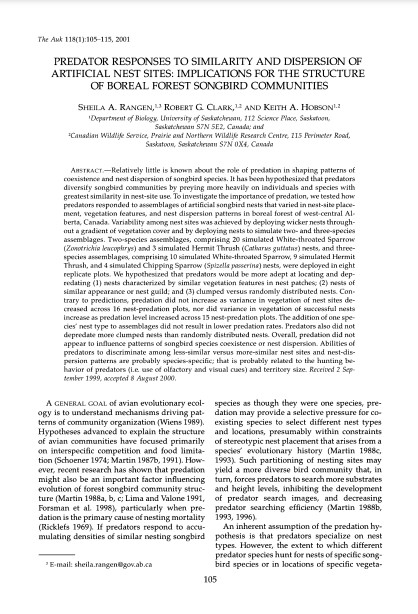Predator Responses to Similarity and Dispersion of Artificial Nest Sites: Implications for the Structure of Boreal Forest Songbird Communities
Bosque Modelo:
Foothills
Temática:
Conservación
Tipo de documento:
Artículo científico
Resumen
Relativelyittle is known about the role of predation in shaping patterns of coexistence and nest dispersion of songbird species. It has been hypothesized that predators diversify songbird communities by preying more heavily on individuals and species with greatest similarity in nest-site use. To investigate the importance of predation, we tested how predators responded to assemblages of artificial songbird nests that varied in nest-site placement, vegetation features, and nest dispersion patterns in boreal forest of west-central Alberta, Canada. Variability among nest sites was achieved by deploying wicker nests throughout a gradient of vegetation cover and by deploying nests to simulate two- and three-species assemblages. Two-species assemblages, comprising 20 simulated White-throated Sparrow (Zonotrichia leucophrys) and 3 simulated Hermit Thrush (Catharus guttatus) nests, and threespecies assemblages, comprising 10 simulated White-throated Sparrow, 9 simulated Hermit Thrush, and 4 simulated Chipping Sparrow (Spizella passerina) nests, were deployed in eight replicate plots. We hypothesized that predators would be more adept at locating and depredating (1) nests characterized by similar vegetation features in nest patches; (2) nests of similar appearance or nest guild; and (3) clumped versus randomly distributed nests. Contrary to predictions, predation did not increase as variance in vegetation of nest sites decreased across 16 nest-predation plots, nor did variance in vegetation of successful nests increase as predation level increased across 15 nest-predation plots. The addition of one species' nest type to assemblages did not result in lower predation rates. Predators also did not depredate more clumped nests than randomly distributed nests. Overall, predation did not appear to influence patterns of songbird species coexistence or nest dispersion. Abilities of predators to discriminate among less-similar versus more-similar nest sites and nest-dispersion patterns are probably species-specific; that is probably related to t
Información Bibliográfica
Autor:
Rangen, SA, RG Clark and KA Hobson.
Revista:
The Auk
Año:
2001
N°:
1
País :
Canadá
Páginas:
105 - 115
Volumen:
118
Idioma:
Ingles
Palabras claves
Nest, forest, eggs, predators





